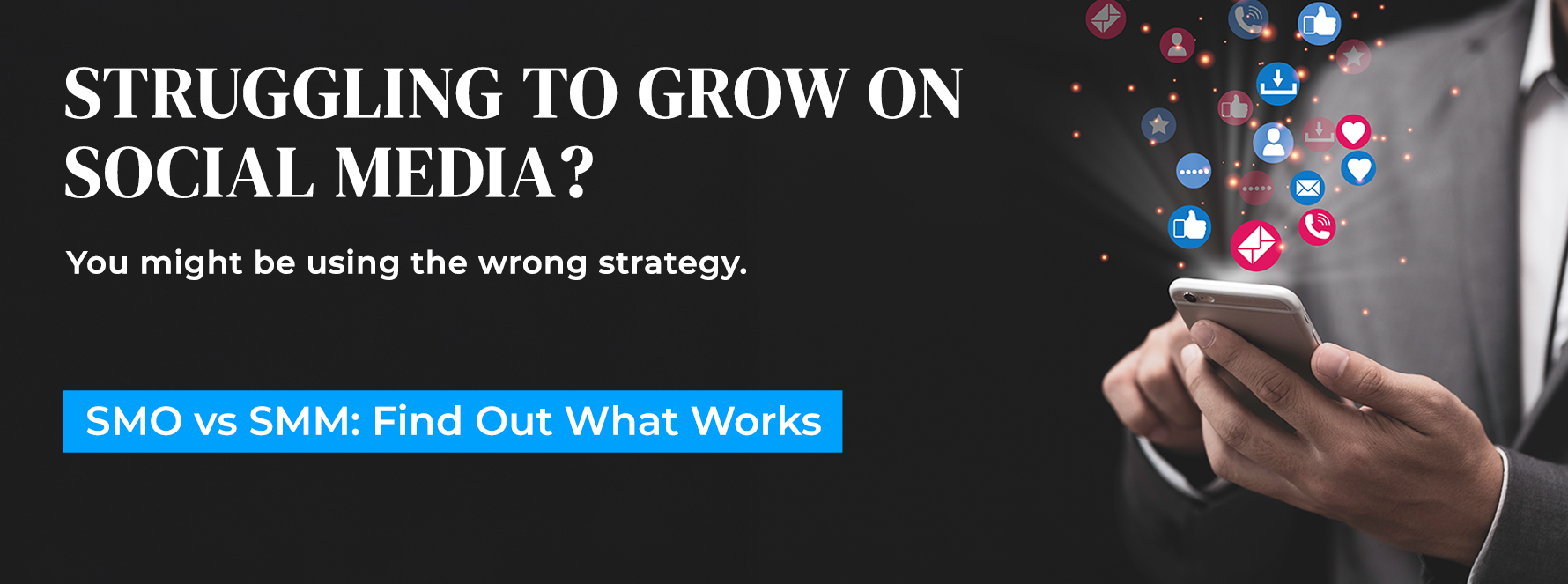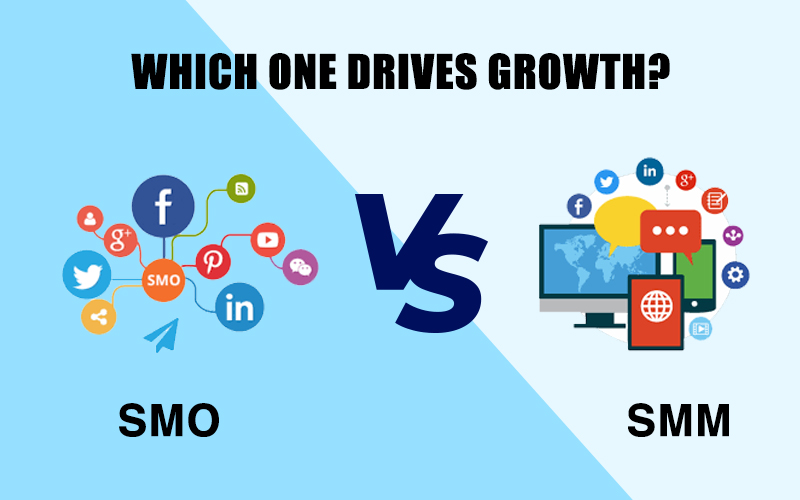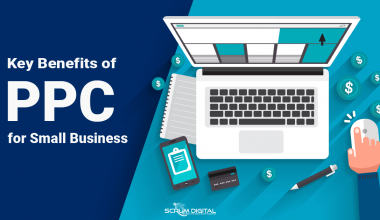In today’s digital-first world, businesses seeking to expand their online presence often face a common question: What’s the difference between SMO vs SMM, and which one do I need? They serve quite different purposes, even though they are both essential parts of a successful digital marketing strategy.
At Scrum Digital, we help businesses across the U.S. harness the power of both SMO (Social Media Optimization) and SMM (Social Media Marketing) to enhance visibility, generate leads, and establish a strong, consistent online brand. In this blog, we break down the difference between SMO and SMM, explore when to use each, and explain why understanding the distinction is crucial for sustainable growth.
What is SMO?
The act of enhancing and boosting your social media presence naturally is known as social media optimization, or SMO. Consider it similar to SEO, but specifically for social media. The goal of SMO is to establish a robust online presence, foster user engagement, and enhance visibility without relying on paid advertisements.
This involves optimizing your social media profiles with consistent branding, strategic keywords, and engaging content that encourages followers to like, comment, and share. For example, optimizing your Instagram bio, maintaining visual consistency across platforms, and crafting engaging, shareable content are all part of SMO marketing.
When done correctly, SMO helps improve your search rankings, enhances brand awareness, and nurtures long-term relationships with your audience, all without spending a dollar on ads.
What is SMM?

Social Media Marketing (SMM) refers to using paid strategies on social media platforms to reach a targeted audience and achieve specific business goals. Whether it’s boosting brand awareness, driving traffic, or generating leads, SMM involves using platforms like Facebook, Instagram, LinkedIn, and YouTube to run paid ad campaigns and promotions.
Key components of SMM marketing include setting up targeted advertisements, running campaigns based on user behavior and interests, retargeting past visitors, and leveraging influencer collaboration to expand reach. It’s all about performance metrics, such as cost per acquisition (CPA), pay-per-click (PPC), and conversion rates.
While SMO focuses on long-term engagement, SMM delivers faster, more measurable results, especially when your goal is lead generation or product promotion.
SMO vs SMM: The Key Differences Explained
While SMO and SMM share the same platforms, their methods and goals are fundamentally different. Here’s a breakdown:
- SMO (Social Media Optimization) is organic. It focuses on enhancing your profiles, creating content that resonates, and encouraging engagement.
- SMM (Social Media Marketing) is paid. It involves running ads, targeting specific demographics, and driving results through budgeted campaigns.
Let’s take a closer look at the major differences:
| Aspect | SMO | SMM |
|---|---|---|
| Approach | Organic optimization | Paid promotion |
| Goal | Boost visibility and engagement | Drive leads, sales, or traffic |
| Tools Used | Hashtags, captions, profile bios | Meta Ads Manager, Google Ads, pixels |
| Cost | Time-intensive, free strategies | Budget-based; measured in CPA/PPC |
| Timeline | Long-term growth | Short-term results |
| Metrics | Followers, shares, engagement rate | ROI, conversions, click-through rate (CTR) |
| Examples | Optimized Instagram bios, hashtags | Targeted Instagram ad campaigns |
Both strategies are essential in the long run, but knowing when and how to use SMO vs SMM will define the success of your digital efforts.
Why Both SMO and SMM Matter for Your Business Growth

One common mistake businesses make is choosing one over the other. The reality is, SMO and SMM work best when combined. Here’s why:
- SMO builds trust and credibility. When your social profiles are complete, visually consistent, and filled with valuable content, visitors are more likely to engage and return.
- SMM provides speed and scale. Paid ads help you reach new audiences, test campaigns, and generate fast results that organic strategies alone may not achieve.
For example, a brand can use SMO to keep its Instagram page active, post updates, and engage followers while running an SMM campaign to promote a limited-time offer. This combination keeps existing followers engaged and brings new ones in through ads.
Real-World Example: SMO + SMM in Action
A dentistry client partnered with Scrum Digital to grow their presence in a competitive local market. Here’s how we used SMO and SMM together:
- We began with SMO by optimizing all their social media profiles, creating consistent branding, using local keywords, and scheduling engaging content across platforms.
- Then, we launched SMM campaigns targeting high-intent users on Instagram and Facebook, using paid ads to promote services like teeth whitening and orthodontics.
The result? Within three months, organic engagement rose by 48%, and the paid campaigns generated over 120 leads at an average CPA 30% below the industry average.
How to Choose Between SMO and SMM (or Use Both)
Here’s how to determine the right strategy for your brand:
- Choose SMO if your goal is to build brand credibility, improve your search rankings, and keep your audience engaged organically. SMO is ideal for businesses focused on long-term growth through meaningful engagement. By consistently posting valuable content, optimizing profiles, and encouraging interaction, you can build a loyal community. It also supports SEO efforts, helping your brand show up more in search results.
- Choose SMM if you need quick wins, such as lead generation, event promotion, or seasonal campaigns. SMM is perfect when you’re aiming for fast, measurable outcomes through paid strategies. Whether you’re launching a new product, promoting a limited-time offer, or trying to fill a sales pipeline, targeted ad campaigns allow you to reach the right people at the right time. It’s highly effective for immediate impact.
- Use both SMO and SMM when you’re looking to scale fast while still building a strong, lasting digital presence. Combining SMO and SMM gives you the best of both worlds, organic trust and paid reach. While SMM delivers short-term results, SMO ensures your presence is consistent and engaging over time. Together, they form a powerful digital marketing engine for sustainable growth.
At Scrum Digital, we tailor digital marketing strategies to fit each client’s needs, whether you’re looking for a stronger Instagram marketing strategy, a unified cross-platform strategy, or highly targeted ads that convert.
Tips for Maximizing SMO and SMM Results

The following are some best practices to remember:
For SMO:
- Keep your brand consistent across all platforms.
- Use relevant hashtags, geotags, and keyword-rich bios.
- Post frequently and use polls, comments, and shares to promote engagement.
- Drive SEO performance by linking your social content back to your blog or website.
For SMM:
- Clearly define goals (brand awareness, traffic, conversions).
- Segment audiences for target advertisements.
- Monitor and optimize performance metrics like PPC, CPA, and return on ad spend.
- Use influencers’ collabs to expand your reach authentically.
Final Thoughts: SMO and SMM for Long-Term Growth
Understanding the core differences between SMO vs SMM is critical for businesses that want to grow intelligently in today’s crowded online space. SMO lays the foundation by building trust, visibility, and brand authority. SMM accelerates growth by putting your offers in front of the right people at the right time.
Rather than choosing between them, a strategic combination ensures that your business stays competitive, both in the search results and on your customers’ feeds.
Ready to Grow with a Winning SMO and SMM Strategy?
At Scrum Digital, we don’t just offer services, we deliver results. Whether you’re a startup looking to gain traction or an enterprise aiming to scale fast, we’ll design a digital marketing strategy tailored to your goals.
Contact us today to get a free audit and learn how SMO and SMM marketing can power your business growth.
Frequently Asked Questions
What’s the difference between SMO and SMM?
SMO focuses on organic social media growth through optimization, while SMM uses paid advertising to target audiences and drive conversions.
Which one is better for my business?
Use SMO for long-term brand building and SMM for quick results – the best strategy combines both for maximum impact.
Does SMO or SMM cost more?
SMO requires time and effort but little budget, while SMM needs ad spend but delivers measurable, faster returns.
Can I use just SMO without SMM?
Yes, but growth will be slower. SMM complements SMO by expanding reach beyond your organic audience.
How quickly do SMO and SMM show results?
SMM campaigns can deliver immediate traffic/sales, while SMO builds gradual but sustainable engagement over months.



